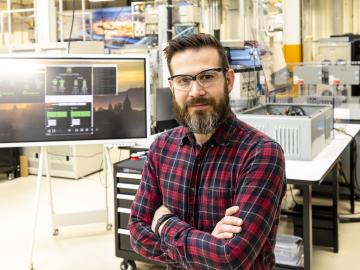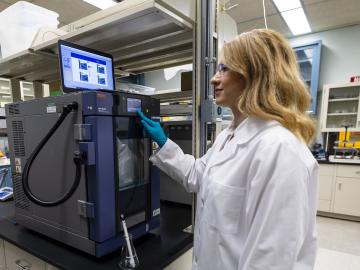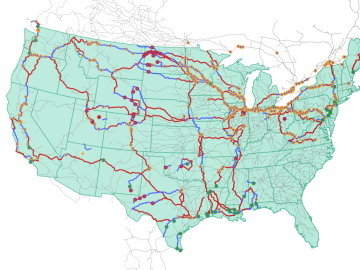
Filter News
Area of Research
- Advanced Manufacturing (3)
- Biology and Environment (18)
- Building Technologies (3)
- Computational Biology (1)
- Computational Engineering (2)
- Computer Science (10)
- Energy Science (78)
- Fusion and Fission (1)
- Fusion Energy (2)
- Isotopes (1)
- Materials (29)
- Materials for Computing (7)
- Mathematics (1)
- National Security (10)
- Neutron Science (6)
- Nuclear Science and Technology (2)
- Quantum information Science (3)
- Supercomputing (26)
- Transportation Systems (2)
News Type
News Topics
- (-) Artificial Intelligence (25)
- (-) Buildings (31)
- (-) Composites (14)
- (-) Computer Science (56)
- (-) Cybersecurity (9)
- (-) High-Performance Computing (23)
- (-) Microscopy (22)
- (-) Nanotechnology (18)
- (-) Polymers (15)
- (-) Security (8)
- (-) Space Exploration (10)
- (-) Transportation (48)
- 3-D Printing/Advanced Manufacturing (47)
- Advanced Reactors (15)
- Big Data (29)
- Bioenergy (40)
- Biology (48)
- Biomedical (24)
- Biotechnology (11)
- Chemical Sciences (22)
- Clean Water (21)
- Coronavirus (17)
- Critical Materials (14)
- Emergency (1)
- Energy Storage (45)
- Environment (88)
- Exascale Computing (4)
- Fossil Energy (1)
- Frontier (4)
- Fusion (18)
- Grid (29)
- Hydropower (8)
- Irradiation (2)
- Isotopes (18)
- ITER (4)
- Machine Learning (24)
- Materials (45)
- Materials Science (49)
- Mathematics (8)
- Mercury (7)
- Molten Salt (5)
- National Security (20)
- Neutron Science (37)
- Nuclear Energy (35)
- Partnerships (4)
- Physics (20)
- Quantum Computing (6)
- Quantum Science (17)
- Simulation (17)
- Statistics (1)
- Summit (10)
Media Contacts

Currently, the biggest hurdle for electric vehicles, or EVs, is the development of advanced battery technology to extend driving range, safety and reliability.

Steven Campbell can often be found deep among tall cases of power electronics, hunkered in his oversized blue lab coat, with 1500 volts of electricity flowing above his head. When interrupted in his laboratory at ORNL, Campbell will usually smile and duck his head.

The common sounds in the background of daily life – like a refrigerator’s hum, an air conditioner’s whoosh and a heat pump’s buzz – often go unnoticed. These noises, however, are the heartbeat of a healthy building and integral for comfort and convenience.

Carl Dukes’ career as an adept communicator got off to a slow start: He was about 5 years old when he spoke for the first time. “I’ve been making up for lost time ever since,” joked Dukes, a technical professional at the Department of Energy’s Oak Ridge National Laboratory.

Madhavi Martin brings a physicist’s tools and perspective to biological and environmental research at the Department of Energy’s Oak Ridge National Laboratory, supporting advances in bioenergy, soil carbon storage and environmental monitoring, and even helping solve a murder mystery.

Mike Huettel is a cyber technical professional. He also recently completed the 6-month Cyber Warfare Technician course for the United States Army, where he learned technical and tactical proficiency leadership in operations throughout the cyber domain.

Oak Ridge National Laboratory researchers used images from a photo-sharing website to identify crude oil train routes across the nation to provide data that could help transportation planners better understand regional impacts.

Growing up exploring the parklands of India where Rudyard Kipling drew inspiration for The Jungle Book left Saubhagya Rathore with a deep respect and curiosity about the natural world. He later turned that interest into a career in environmental science and engineering, and today he is working at ORNL to improve our understanding of watersheds for better climate prediction and resilience.

An advance in a topological insulator material — whose interior behaves like an electrical insulator but whose surface behaves like a conductor — could revolutionize the fields of next-generation electronics and quantum computing, according to scientists at ORNL.

ORNL scientists found that a small tweak created big performance improvements in a type of solid-state battery, a technology considered vital to broader electric vehicle adoption.


